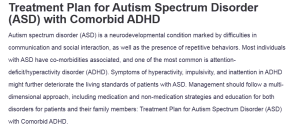Treatment Plan for Autism Spectrum Disorder (ASD) with Comorbid ADHD
Autism spectrum disorder (ASD) is a neurodevelopmental condition marked by difficulties in communication and social interaction, as well as the presence of repetitive behaviors. Most individuals with ASD have co-morbidities associated, and one of the most common is attention-deficit/hyperactivity disorder (ADHD). Symptoms of hyperactivity, impulsivity, and inattention in ADHD might further deteriorate the living standards of patients with ASD. Management should follow a multi-dimensional approach, including medication and non-medication strategies and education for both disorders for patients and their family members: Treatment Plan for Autism Spectrum Disorder (ASD) with Comorbid ADHD.
Psychopharmacology
Drugs are effective in reducing ADHD symptoms in individuals with ASD. Probably the most commonly used stimulant medications raise the level of dopamine and norepinephrine in the brain, thereby improving attention and impulse control: Methylphenidate, better known as Ritalin. The initial dosage typically begins at 5 mg once daily and is titrated weekly based on the individual’s response, up to a maximum dosage of 60 mg per day (Jaeschke et al., 2021). Administering the medication in the morning helps minimize insomnia, a frequent side effect.
Other possible side effects include loss of appetite, irritability, and mood swings. Methylphenidate depresses appetite, leads to restlessness, and causes mood swings. The growth and eating patterns of the patient should be closely monitored to detect and treat any nutritional problems early. Caregivers are recommended to notify healthcare professionals without delay if the patient shows marked behavioral changes or drug-related adverse reactions.
Healthcare professionals consider Methylphenidate an essential component of treatment for its effectiveness in reducing hyperactivity and enhancing focus. Patients need follow-up appointments to help doctors find the best dosage and control side effects to achieve good treatment results.
Nonpharmacological Treatments
Nonpharmacological interventions are important in the management of ASD and ADHD. ABA is aimed at changing behaviors, especially through reinforcement. ABA is effective for challenges such as poor task focus, compliance, and social skill deficits; it offers a structured approach tailored to individual needs.
Cognitive behavior therapy supplements ABA by helping patients recognize the emotional triggers of their actions, ways to cope with emotions, and control their behavior. CBT is most effective in treating unstable emotions and impulsive behaviors (Drechsler et al., 2020). In the CBT treatment, a patient learns to become aware of their thoughts and behaviors to have better control over anxious social interactions.
For this to be successful, such treatment plans must be consistent across all environments, whether it be at home, at school, or the treatment facility. Caregivers and educators must collaborate to reinforce continued behavioral growth by incorporating therapeutic techniques into daily life.
Patient and Family Teaching
Education for patients and families is a crucial aspect of the treatment plan. Caregivers must understand the importance of adhering to prescribed medications and monitoring for potential side effects. A behavioral log can help track changes and patterns, aiding follow-up consultations. Clear communication with healthcare providers ensures timely adjustments to treatment plans (Drechsler et al., 2020).
Equally, families should be trained in techniques to apply behavioral interventions at home. More structured routines, visual schedules, and consistent reinforcement of positive behaviors help broaden the benefits of ABA and CBT. It improves the person’s functioning while reducing caregiver stress by creating an environment that makes it easier for them to respond appropriately (Cross et al., 2020).
Joining support groups is valuable to caregivers, as they can connect with others, share experiences, and obtain practical advice. More importantly, stress management techniques, like mindfulness and relaxation exercises, all help to maintain a supportive home environment. Knowledge is a way to empower families so that they can actively be involved in the treatment process and be able to advocate for their loved ones.
Conclusion
A holistic treatment plan that combines pharmacological with nonpharmacological interventions, along with extensive family education, is needed to handle the complexities of ASD and ADHD. Medications such as Methylphenidate are used in addressing major symptoms of ADHD, while therapies like ABA and CBT help in teaching the individual different skills in managing their own emotions and behaviors. Family involvement in the treatment process and equipping them with the right tools fosters cooperation and better results. Consistent monitoring and collaboration among healthcare providers, families, and educators create a supportive environment where individuals can thrive.
References
Cross, A. J., Elliott, R. A., Petrie, K., Kuruvilla, L., & George, J. (2020). Interventions for improving medication-taking ability and adherence in older adults prescribed multiple medications. Cochrane Database of Systematic Reviews, 5(5). https://doi.org/10.1002/14651858.cd012419.pub2
Drechsler, R., Brem, S., Brandeis, D., Grünblatt, E., Berger, G., & Walitza, S. (2020). ADHD: Current concepts and treatments in children and adolescents. Neuropediatrics, 51(5), 315–335. https://doi.org/10.1055/s-0040-1701658
Jaeschke, R. R., Sujkowska, E., & Sowa-Kućma, M. (2021). Methylphenidate for attention-deficit/hyperactivity disorder in adults: A narrative review. Psychopharmacology, 238(10), 2667–2691. https://doi.org/10.1007/s00213-021-05946-0
ORDER A PLAGIARISM-FREE PAPER HERE
We’ll write everything from scratch
Question
Details
Autism spectrum disorder (ASD) often coexists with many other behavioral health conditions.
- Identify one potential comorbid diagnoses often associated with ASD.
- Develop a treatment plan for a patient with ASD and your chosen comorbidity.
- Include any medications with all prescribing information, teaching, side effects and rational
- Also include any nonpharmacological treatment options with rational
- Describe teaching you would provide to the patient and family.
Criteria
ASD comorbidity
One comorbidity correctly identified.
Psychopharmacology
Full list of medication classes used for the listed for chosen comorbidity including prescribing information, teaching SE and rational for one drug.

Treatment Plan for Autism Spectrum Disorder (ASD) with Comorbid ADHD
Nonpharmacological treatment
Two nonpharmacological treatments of ASD listed as well as rational.
Patient and Family Teaching
Include full teaching information for the patient and their family
APA Format
Grammar
Text:
- DSM-5-TR text

